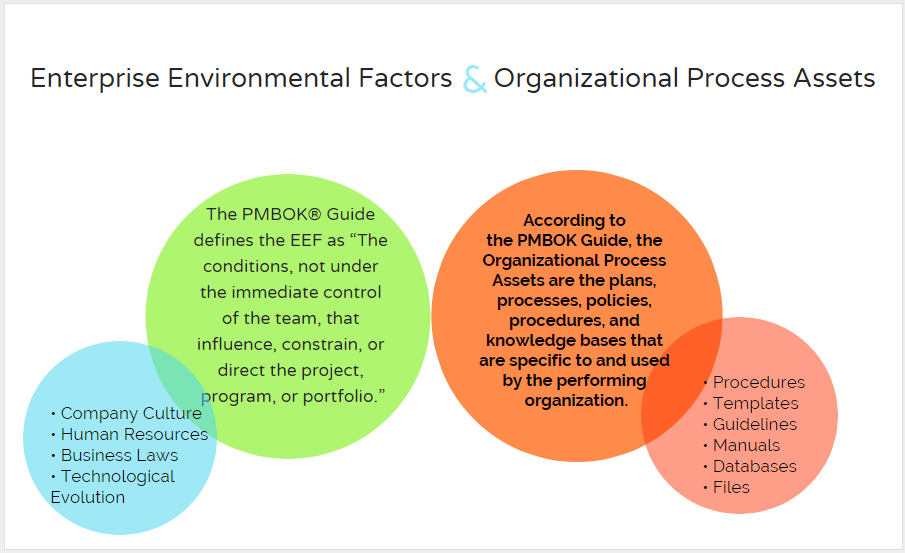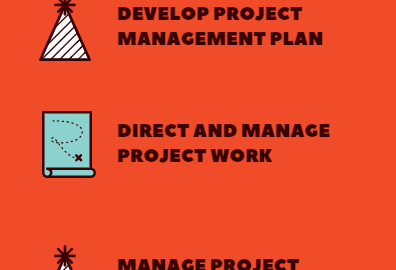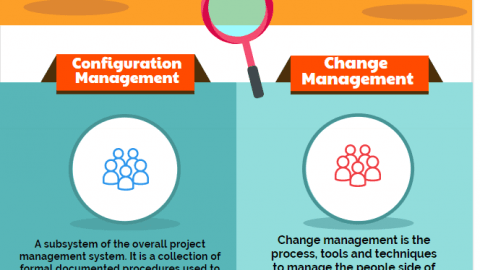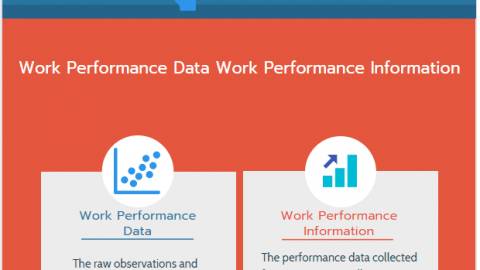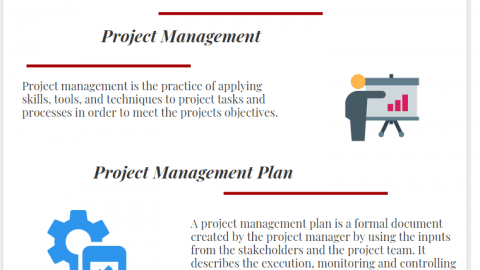Enterprise Environmental Factors vs Organizational Process Assets
Enterprise Environmental Factors (EEF) and Organizational Process Assets (OPA) are the inputs of the project integration management processes. These concepts have extensive coverage in the PMBOK Guide. Both concepts are easily understandable however, many PMP aspirants have difficulty to understand. Enterprise Environmental Factors (EEF) and Organizational Process Assets (OPA) are important concepts for project management processes. Therefore you must understand both concepts to pass the PMP Certification exam. Maybe you will not encounter questions during the exam directly related to them but knowing both concepts provides a better understanding of other project management processes. In this article, we will discuss both Enterprise Environmental Factors (EEF) and Organizational Process Assets (OPA) concepts and the key differences between them.
Table of Contents
What are the Enterprise Environmental Factors?
The environment can be everything living or non-living around us. Physical, natural and chemical things, conditions form the environment. So that it has impacts on humans and projects. For example weather conditions such as excessive precipitation or blowing snow slow down a construction project. In this example, severe weather conditions are the environment which has negative effects on the project’s performance.
The PMBOK® Guide defines the EEF as “The conditions, not under the immediate control of the team, that influence, constrain, or direct the project, program, or portfolio.”
The EEF have effects on the projects, organizations and project teams. It can be classified as internal EEF and external EEF. Note that Enterprise Environmental Factors are an output of the executing process of project human resource management.
Typical examples of enterprise environmental factors are below
Enterprise Environmental Factors Example in Project Management
Internal Enterprise Environmental Factors
• Company Leadership Styles
• Company Culture
• Types of Organizational Structures
• Employee’s Efficiency
• Human Resources
• Organizational Communication Channels
External Enterprise Environmental Factors
• Market Conditions
• Business Laws
• Technological Evolution
• Legal, Ethical and Political Environment
• Government and Industry Standards
What are the Organizational Process Assets?
Up to this section, we discussed the Enterprise Environmental Factors. Now we will talk about the Organizational Process Assets. Assets are useful or valuable things, inventories that an organization or an individual owns. For instance, manufacturing machines are the assets of a pharmaceutical plant. Or your computer that helps you to connect internet is your asset. Assets may also be templates, procedures, documents as well as manufacturing machines or computers.
Organizations use assets while performing their businesses. So they are called the Organizational Process Assets.
According to the PMBOK Guide, the Organizational Process Assets are the plans, processes, policies, procedures, and knowledge bases that are specific to and used by the performing organization.
In other words, The Organizational Process Assets are the properties of an organization which helps the organization to achieve its goals.
Organizations create templates, contracts, registers, forms, plans in order to conduct project management activities. The Organizational Process Assets represent the company’ s know-how.
Here is a list of Organizational Process Assets
As you see that Enterprise Environmental Factors and OPA are two different concepts. Organizational Process Assets can be classified into two categories. The first category includes policies, procedures, and templates that help an organization to conduct works. The second category includes records and archives related to past projects. Risk register, stakeholder register, methods, historical records, etc.
• Procedures
• Templates
• Guidelines
• Manuals
• Databases
• Files
• Schedules
• Diagrams
• Processes
• Reports
• Systems
The Organizational Process Assets involve very important project documentation that helps an organization to become more efficient. For instance, let’s assume that you will create a stakeholder register for a new project. The first thing to do is to check the previous project’s records related to the stakeholders. You will customize the stakeholder register template for the new project and obtain the list of stakeholders on the same location. This will save your time and prevent you to miss the important stakeholders.
Organizational Process Assets and Enterprise Environmental Factors Differences
As discussed above, Enterprise Environmental Factors (EEF) and Organizational Process Assets (OPA) are two different concepts. Below are some of the differences between them.
- Organizational process assets are the organization’s inventory and documents that can be changed or modified. On the other hand, EEF are the conditions mostly out of the organization’s control such as government regulations.
- Improving the OPA improves the processes of an organization. On the other hand, EEF may have positive or negative effects on a project depending on the conditions.
- Organizational process assets support the organization’s efficiency and continuity. By the help of OPA, the organizations improve their process and increase their productivity. OPA are related to the organization’ s outputs and product quality.
- Enterprise environmental factors may have positive or negative effects on an organization. Internal enterprise environmental factors are under control of the project management team but external enterprise environmental factors are not. Enterprise environmental factors are related to the organization’ s structure and the market.
- EEF may limit the project team. On the other hand, OPA improve the teams work and help to save time.
Summary
Enterprise environmental factors are mostly out of your control such as political climate or a change in tax rates. However effective planning and control practices help to improve decision making so that you can minimize the negative effects of EEF by early responses.
On the other hand, organizational process assets are the records and knowledge base of an organization that has influences of the organization’s success. Keeping and storing the records systematically make the project’s team’s work more efficient. In this article, we review both enterprise environmental factors and organizational process assets concepts. Note that these concepts are important from the PMP Certification exam point of view because they are related to project integration management processes.

Brantlee Bhide is a project manager at HB Consultancy. She has 16 years of experience working as a project professional across varying industries, countries, and cultures. She operates in both business and technical domains using an approach that she developed.

